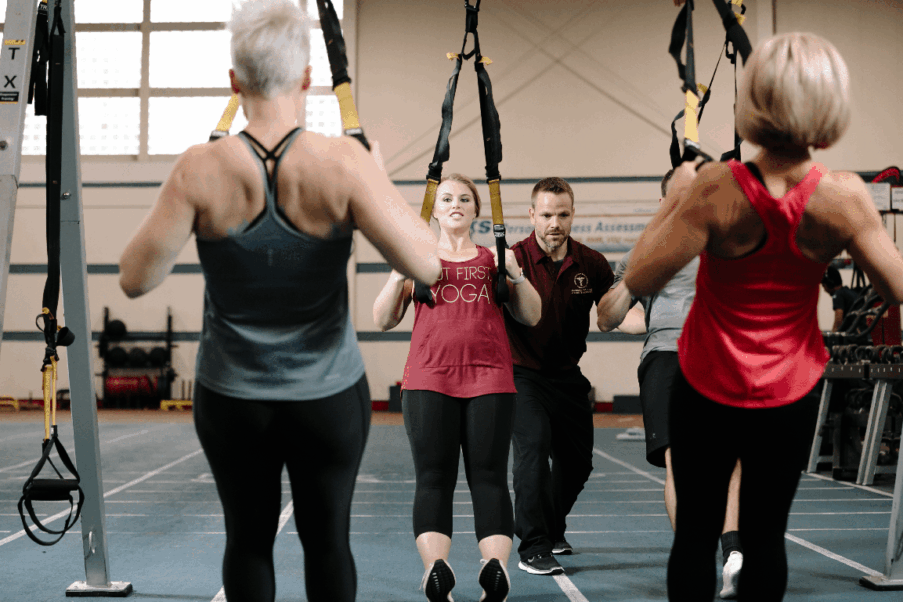A Holistic Approach to Health
Go beyond physical exercise to offer extras that attract people to your facility.
Treadmills, free weights, resistance training machines—your facility has it all. You offer everything anyone could want in terms of achieving an optimal physique. And certainly, physical fitness is vital to overall health, but it is not the whole story. Multiple factors affect well-being. By embracing them, you can transform your facility into more than just a place to work out. Specifically, you can adopt a holistic approach and expand your wellness offerings to address four main dimensions of health—physical, emotional/spiritual, intellectual and social.
Discover why catering to these four dimensions can benefit your clients, and sample some of the programs you can offer.
Facilities that adopt the whole-person wellness model enrich the lives of their members. “A more holistic approach to lifestyle change has the potential to enhance exercise adherence and a commitment to a healthy lifestyle,” explains Barbara A. Brehm, EdD, professor and chair of the department of exercise and sport studies at Smith College in Northampton, Massachusetts. “When you help your clients develop a more balanced lifestyle, they may be better able to make their health and fitness a priority.”
Furthermore, such facilities attract additional members since multidimensional programming reaches a wider audience. In other words, what’s good for the customer is also good for business (Milner 2002).
In fact, “Fitness American Style,” a national consumer study commissioned by the International Health, Racquet & Sportsclub Association, determined that major segments of the American population currently adopt a more holistic definition of good health and fitness (Faiman 2002). It’s time to take advantage of this fact and emphasize a global strategy to help members achieve greater health and minimize medical problems. Here’s how.
As a fitness facility, you’ve pretty much got this area covered. Between your equipment and exercise classes, you presently offer clients countless opportunities to improve physical health. That being said, you may want to consider offering additional services, such as postrehabilitation programs and regular screenings.
In regard to postrehab services, individuals who need muscular conditioning following injury or surgery compose a surprisingly large segment of our population (Westcott & D’Arpino 2002). You can provide safe and productive programs to restore or improve fitness levels in postrehab clients. These programs are typically administered by exercise physiologists or physical therapists who have experience with specific injuries or conditions. The goal is to create a more functional lifestyle and reduce the risk of reinjury.
For example, the Robert Wood Johnson Hamilton Center for Health & Wellness, located in Mercerville, New Jersey, offers rehabilitation services, a staff of nurse educators, a health library with computer access and a healthy-cooking kitchen (www.rwjhamilton.org).
Screenings are also essential in the prevention of many diseases, so get your clients off to a great start by regularly offering screening events. They can include blood pressure assessments, cholesterol testing, bone density scans . . . you name it. To obtain information on setting up screenings, contact local chapters of nonprofit organizations like the American Heart Association and the National Osteoporosis Foundation.
People who are emotionally and spiritually healthy are in control of their thoughts and behaviors, feel good about themselves and keep problems in perspective. This type of mental fortitude goes a long way in boosting one’s overall quality of life. Here are several ideas for how you can foster this inner strength at your facility.
Help Clients Relieve Stress. Stress is common in today’s society and plays a significant role in negatively impacting emotional health. By offering stress management workshops, you can be a part of the solution. In addition, consider designating a room or specific area as your relaxation section. Set up couches for rest, play soft music as opposed to the upbeat music played throughout the rest of the facility and offer helpful books and other tools that alleviate stress. This may encourage busy people to slow down and relish a much-needed break. The Wellness/ Recreation Center at the University of Northern Iowa in Cedar Falls is an excellent example of a facility that helps clients reduce stress. It provides a wellness resource room featuring stress-reducing items like recliners, drum sticks, massage gadgets and even Play-Doh®.
Create an On-Site Spa. You can even take stress reduction a step further and establish an on-site spa. It needn’t be state-of-the-art. You can partner with a local spa company or just transform a small section of your facility into a quiet haven where clients can indulge in services like massages, facials and body wraps. Massage in particular offers a host of benefits, which include alleviating low-back pain, boosting immunity by stimulating lymph flow, and relieving depression (Associated Bodywork & Massage Professionals 2007).
When setting up and marketing your spa services, remember to educate members on the health benefits. Present educational sessions once a quarter to teach members about the positive effects that spa services have on physical, mental and emotional states. You can encourage members to attend your educational events by offering special values on those days (Berger 2005).
Consider Other Options. In addition to these services, simple events like nature walks, outdoor picnics and meditation classes can give members the emotional and spiritual boost that they need.
The more your clients comprehend wellness concepts and facts, the more empowered they are to take charge of their overall well-being. Be their resource for this information.
Present Frequent Educational Events. Consider inviting speakers on a variety of health and medical topics. A program like this can be profitable for your business and offer a stimulating intellectual experience for attendees. By opening the event to both members and nonmembers, you introduce potential future customers to your facility (Milner 2002). In addition to speaker events, you can conduct cooking demonstrations, book reviews of recent health-related publications and sport-specific presentations.
Provide Free Handouts. Another simple, inexpensive way to offer knowledge to your clients is to give out free handouts on wellness topics, including body image, heart rate, sports injury prevention and the body-mind connection. Create your own handouts, photocopy those at the back of IDEA Fitness Journal or find a selection at www.fitnessmanagement.com.
Educate Clients About Nutrition. An often overlooked area of knowledge is nutrition. Your facility can inform clients about this topic by hiring a registered dietitian to offer one-on-one consultations, answer questions and set up individualized diet programs (Kufahl 2004). Members can either pay a fee for these services or pay more for general membership but get complementary services from the dietitian. Additionally, you can organize group classes on nutrition basics, as well as targeted classes, such as nutrition for weight loss, for new mothers or for marathon runners. Lastly, offering legitimate information regarding diet supplements and sports drinks is a value-added service for your clients (Pitts 2000). Many businesses offer a wall of sports drinks and supplements with little accompanying education. With the supplement industry awash with conflicting information and claims, your members can find themselves confused or, even worse, deceived. Simple handouts or informative sessions make a significant difference in members’ understanding of these dietary products and establish your facility as a trusted source.
Social support is essential for living a healthy life and achieving goals. Your facility can provide emotional support by establishing social networks and friendships among members (Brehm 2001). Foster a sense of group belonging by creating clubs within your facility, hosting social events and offering unique programs and events that bring people together.
The concept of creating smaller clubs within a fitness business is not new, but you can invent some new twists. Walking clubs and book clubs are popular, but use your imagination to come up with innovative ideas. The Fitness Edge, with locations throughout Connecticut, offers a “Backyard Boot Camp” program in which members gather a group of friends to form their own little club. Some of the facility’s trainers then lead an effective, fun exercise program for 6 weeks at one member’s home.
Social events can also bring members together. Events such as member appreciation dinners, humorous workshops or group outings help people get to know one another outside of the gym environment.
Another creative way to assemble members is to take advantage of national health observance themes to sponsor health promotion events, stimulate awareness of health risks and focus on disease prevention. The U.S. Department of Health and Human Services, along with other nonprofit agencies, has designated each month of the year as a time to pay attentain conditions. Hosting monthly events with vendors, speakers and entertainment will not only bring people together but also generate ancillary revenue.
Consumers are now making the connection between fitness, health and wellness services. Therefore, motivation for joining a fitness facility has migrated from individuals who want a better physical appearance to those interested in overall well-being. Your facility can meet this need—enriching people’s lives and putting the “health” back in “health club.”
National Health Information Center, www.healthfinder.gov/library/nho/ nho.asp
The Health Fitness Center at Midtown, Atlanta, www.hfitcenter.com
References
Berger, T. 2005. Educating members about the benefits of spa services. Fitness Management (June).
Brehm, B. 2001. Holistic health: Body, mind, and spirit. Fitness Management (April).
Faiman, M. 2002. A new motivation for joining a gym has emerged. Recreation Management.
Kufahl, P. 2004. A nod to nutrition. Fitness Business Pro (May 1).
Mercer County Chamber of Commerce. 2004. Working out for wellness. Mercer Business (Aug. 1).
Milner, C. 2002. The six dimensions of wellness for older adults. Fitness Management (Oct.).
Pitts, E. 2000. Supplements are now a fact of life. Fitness Management (May).
Westcott, W., & D’Arpino, T. 2002. Strength training for physical rehabilitation. Fitness Management (Feb.).





